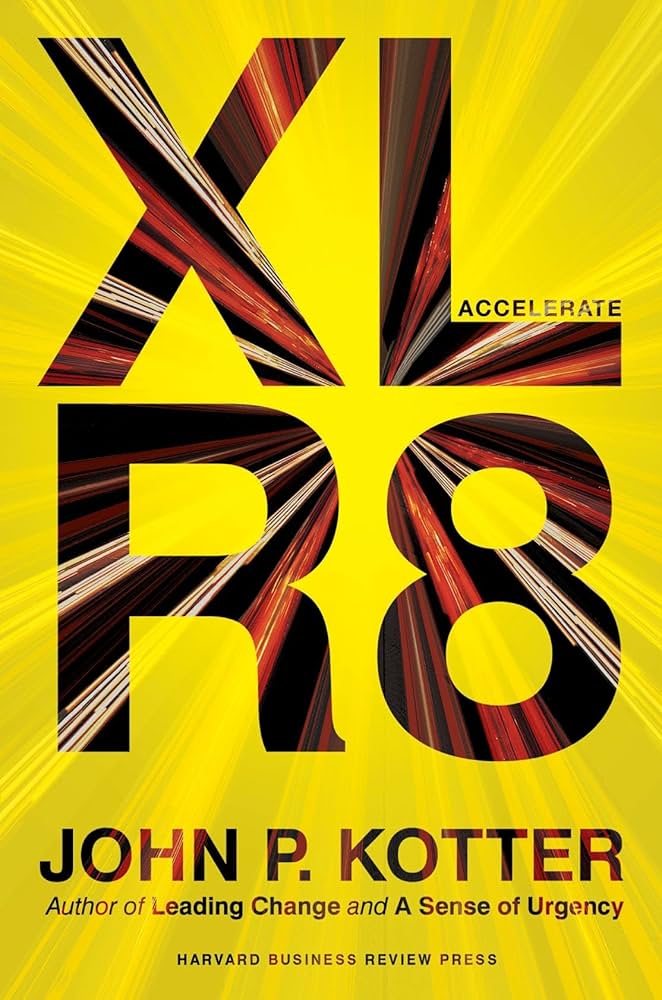Insights from “Accelerate” by John Kotter: How to Lead Change in a Fast-Paced World

Book: Accelerate: Building Strategic Agility for a Faster-Moving World
Autor: John Kotter
Título Original: Accelerate: Building Strategic Agility for a Faster-Moving World
Ano de Edição: 2014
Edição: 1ª
Páginas: 224
In today’s rapidly changing environment, businesses need more than traditional structures to thrive. In “Accelerate”, John Kotter introduces a dual operating system designed to foster agility and innovation while maintaining operational stability. This framework empowers organizations to adapt to disruption, create urgency, and achieve sustainable growth.
The Eight Accelerators: A Deep Dive
1. Create a Sense of Urgency
Kotter emphasizes the need for urgency to kickstart change. Without it, teams often default to complacency or resistance. Urgency comes from presenting compelling data, such as customer complaints, declining market share, or new opportunities that demand immediate attention.
- How to Implement:
- Share stories and insights that emotionally resonate with employees.
- Use hard data to highlight the consequences of inaction.
2. Build a Guiding Coalition
To lead change effectively, Kotter advocates assembling a coalition of passionate, credible individuals across departments and levels. This group acts as the driving force for the agile network.
- Characteristics of a Strong Coalition:
- Diversity in skills, experience, and hierarchy.
- Shared vision and commitment to driving change.
3. Develop a Vision and Strategy
A clear vision and strategy serve as the compass for all change efforts. The vision should inspire, while the strategy provides the roadmap.
- What Makes a Good Vision:
- Easy to understand.
- Bold enough to excite but realistic enough to achieve.
- Example: “Transform into the market leader in sustainability by reducing carbon emissions 50% by 2030.”
4. Communicate the Vision
Effective communication ensures everyone in the organization understands and aligns with the vision. According to Kotter, leaders should communicate the vision 10 times more than they think necessary.
- Tips for Communication:
- Use multiple channels: meetings, emails, videos, and informal conversations.
- Keep the message consistent, simple, and inspiring.
5. Empower Action by Removing Barriers
Barriers such as outdated processes, rigid hierarchies, or lack of resources often stall progress. Leaders must identify and eliminate these obstacles to empower employees to act.
- Examples of Barriers and Solutions:
- Bureaucracy: Streamline approvals for new ideas.
- Lack of training: Provide upskilling programs to help employees adapt to new technologies.
6. Generate Short-Term Wins
Celebrating small victories along the way boosts morale and reinforces the momentum for change. These wins demonstrate that progress is achievable and encourage teams to stay engaged.
- Characteristics of Short-Term Wins:
- Highly visible and meaningful to employees.
- Achievable within 6-12 months.
- Example: Launching a new customer service app within 3 months that improves response times by 20%.
7. Sustain Acceleration
Change efforts often lose steam after initial wins. Kotter stresses the importance of maintaining momentum by building on successes and tackling larger challenges.
- How to Sustain Momentum:
- Continuously refine processes and strategies.
- Involve more employees in the agile network to scale efforts.
- Regularly measure and communicate progress to keep urgency alive.
8. Institutionalize Change
The final accelerator involves embedding new behaviors and practices into the organization’s culture to ensure lasting transformation.
- How to Institutionalize Change:
- Align rewards and recognition systems with new behaviors.
- Train leaders to model and reinforce the desired changes.
- Continuously communicate the benefits of the transformation.
Actionable Strategies for Implementing Kotter’s Ideas
Start Small but Think Big
Pilot the dual operating system in a specific department or project before scaling across the organization.Empower Leadership Across Levels
While senior leadership provides vision, mid-level managers and employees act as change agents who carry out initiatives.Leverage Data to Build Urgency
Present tangible evidence—such as shifting market trends or customer feedback—that demonstrates the need for immediate action.
Final Insights: Driving Transformation with Agility
Kotter’s “Accelerate” is not just a guide—it’s a call to action for organizations to rethink their structures in the face of disruption. The dual operating system allows companies to pivot without compromising their foundation.
Key Takeaway:
Innovation and stability are not mutually exclusive. Leaders who embrace Kotter’s framework can create an organization capable of thriving in both calm and chaotic times.
